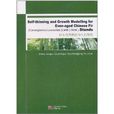《杉木自然稀疏與生長模擬》是2011年科學出版社出版的圖書,作者是張建國。
基本介紹
內容簡介,圖書目錄,
內容簡介
《杉木自然稀疏與生長模擬(英文版)》基於杉木密度試驗林長期定位觀測資料,系統解決了杉木林分生長模型系統中優勢高生長模型、斷面積生長模型以及直徑結構模型等三大核心模組的構建問題,深入揭示了杉木人工林自然稀疏法則,實現了杉木最大密度線模擬技術的系統最佳化。《杉木自然稀疏與生長模擬(英文版)》共分4部分,圍繞杉木優勢高生長模擬、斷面積生長模擬、直徑結構模擬和杉木自然稀疏模擬等進行了論述,闡釋了各部分研究的進展,創新性地提出了林分直徑結構模擬新模型及其模糊分布擬合思路,提出杉木優勢高、斷面積生長的代數差分方程及廣義代數差分方程模擬技術,首次驗證分析了杉木自然稀疏法則與發生軌跡,並從數據點選取、參數估計方法角度建立了杉木最大密度線模擬技術體系。
圖書目錄
Preface
CHAPTER ONE: Modelling of dominant height growth and building of polymorphic site index equations of chinese fir plantations
1 Introduction
2 Material and methods
3 Results and analysis
4 Conclusions
CHAPTER TWO: A review of stand basal area growth models
1 Introduction
2 Features of stand basal area growth models
3 Types of models
4 Early work on stand basal area models
5 Recent progress and future directions
6 Conclusions
CHAPTER THREE: Individual tree basal area growth dynamics of chinese fir
plantations
1 Introduction
2 Materials and methods
3 Results and discussion
4 Conclusion
CHAPTER FOUR: Application of theoretical growth equations for stand
diameter structure simulation of chinese fir plantations
1 Introduction
2 Materials and methods
3 Results and analysis
4 Conclusions
CHAPTER FIVE: A new high-performance diameter distribution function for unthinned chinese fir (Cunninghamia lanceolata) Plantations in southern China
1 Introduction
2 MATERIALS AND METHODS
3 RESIILTS AND DISCUSSION
4 Conclusions
CHAPTER SIX: Application of fuzzy functions in stand diameter distributions of chinese fir (Cunninghamia lanceolata) plantations
1 Introduction
2 Data and Methods
3 Results and Discussion
4 Conclusion
CHAPTER SEVEN: Testing the self-thinning rule in chinese fir (Cunninghamia lanceolata) plantations
1 Introduction
2 Materials and methods
3 Results
4 Discussion
CHAPTER EIGHT: Estimation of the self-thinning boundary line within even-aged chinese fir (Cunninghamia lanceolata (Lamb.) Hook.) stands: Onset of self-thinning
1 Introduction
2 Materials and Methods
3 Results
4 Discussion
5 Conclusions
CHAPTER NINE: A comparison of methods for estimating the self-thinning
boundary line: selecting data points and fitting coefficients
1 Introduction
2 Material and Methods
3 Results and Discussion
4 Conclusions

